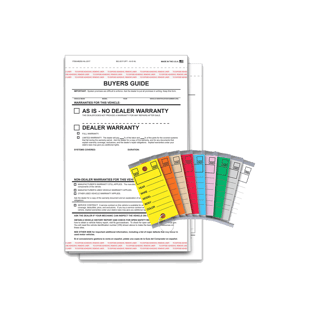
The New IRS EV Tax Credits Are Now in Effect, as of April 18, 2023
The IRS updated which vehicles qualify for EV tax credits under the Inflation Reduction Act (IRA). For further information, you should review this fact sheet provided by the IRS. While the basic functioning of tax credits remains the same, the criteria have been refined to restrict the selection of qualifying vehicles and individuals. The fact sheet provides comprehensive information on the alterations made and also includes links to the lists of vehicles that meet the criteria.
PARTNER SPOTLIGHT
Dealer Management System, Computer Technology, Media/Advertising, Automotive Auction, F & I/Aftermarket Products, Automotive Technology Training & Compliance
 A NHADA Gold PARTNER
A NHADA Gold PARTNERComputer Technology, Automotive Shop Equipment, Environmental Services
 A NHADA Platinum PARTNER
A NHADA Platinum PARTNERF & I/Aftermarket Products, Automotive Technology Training & Compliance, Environmental Services
.png?width=150&name=corp_logo_horz_on_light_with_trademark_symbol_1200w%20(002).png) A NHADA Diamond PARTNER
A NHADA Diamond PARTNERF & I/Aftermarket Products, Financial Services, Automotive Technology Training & Compliance
 A NHADA Diamond PARTNER
A NHADA Diamond PARTNEREffective April 18, 2023, the list of battery electric vehicles (BEVs) and plug-in hybrid electric vehicles (PHEVs) eligible for IRC Section 30D tax credits declined based on the battery and critical mineral content criteria in the Inflation Reduction Act of 2022.
For a list of all qualifying make/models/variants see: Federal Tax Credits for Plug-in Electric and Fuel Cell Electric Vehicles Purchased in 2023 or After (fueleconomy.gov). Note that two search categories (“Purchase Scenarios”) are available: One for vehicles placed in service between Dec. 31, 2022, and April 17, 2023; and one for vehicles placed in service on or after April 18, 2023.
These changes result from the publication by the IRS of proposed rules implementing IRC Section 30D’s battery and critical mineral content requirements. Simply put, whether and to what extent a make/model qualifies for an IRC Section 30D credit when placed in service after April 17, 2023, will depend on where its EV battery components and the critical minerals used in its battery are sourced. Of course, consumers really don’t need to know the specifics regarding battery and mineral content; in this context, the only relevant piece of information for a consumer considering purchasing an EV is whether or not that vehicle is on the list of those eligible for a tax credit.
Per the IRS website, 22 EVs will qualify for IRC Section 30D tax credits, down from 41. Of these, 14 will qualify for the full $7,500 credit and 8 will qualify for $3,750. Make note that all of these vehicles (and other EV makes/models that don’t qualify for an IRC Section 30D credit) potentially qualify for an IRC Section 45W tax credit if sold to commercial customers, including leasing companies.
There is an alternative to the IRC Section 30D new EV sales credits and their restrictive battery, final assembly, MSRP, and income criteria. Under IRC Section 45W, a commercial taxpayer can purchase a qualified commercial clean vehicle (CCV), lease it to a commercial or noncommercial customer, and pass on to the lessee the value of the anticipated tax credit in the form of a capitalized cost reduction allowance (CCRA). In this way, OEMs and dealers can convert EV sales customers to lease customers, and non-EV customers to EV lease customers, regardless of a vehicle’s price, its battery and critical mineral content, its final assembly location, or a customer’s modified adjusted gross income.
Under the Section 45W rules, CCVs include BEVs, PHEVs, and fuel cell electric vehicles (FCEVs). The tax credit is valued at 30% of the basis price for BEVs and FCEVs and 15% of the basis price for PHEVs.
A CCV includes any vehicle:
- the original use of which commences with the taxpayer;
- acquired for use or lease by the taxpayer and not for resale;
- made by a qualified manufacturer;
- treated as a motor vehicle for purposes of Title II of the Clean Air Act;
- propelled to a significant extent by an electric motor that draws electricity from a battery with a minimum capacity of 7 KWh for CCVs of less than 14,000 pounds GVWR, and 15 KWh for CCVs greater than 14,000 pounds GVWR;
- capable of being recharged from an external source of electricity or is a FCEV based upon the requirements of section 30B; and
- that is of a character subject to the allowance for depreciation.
CCVs below 14,000 pounds GVWR are eligible for a credit of up to $7,500 (and CCVs 14,000 pounds GVWR and more are eligible for up to $40,000).
Tax-exempt entities, including federal, state, and local governments, may elect to receive direct payments.
The Section 45W credit took effect after December 31, 2022, and ends on December 31, 2032.
EV manufacturers with vehicles not eligible for a Section 30D sales credit have worked with finance sources to commence leasing programs to take advantage of Section 45W. Contact your finance sources to find out about these lease transaction opportunities.
For more information on the Section 45W tax credit, see www.irs.gov/credits-deductions/commercial-clean-vehicle-credit.
NADA members can visit www.nada.org/ev-incentives or contact regulatoryaffairs@nada.org for more information on the IRC Section 30D tax credits, the IRC Section 45W tax credits, or any other EV incentives.
Article Sources:
The Internal Revenue Service
Massachusetts State Automobile Dealers Association (MSADA)
Fueleconomy.gov
National Automobile Dealers Association
Washington Area New Auto Dealers Association


















.png?width=150&name=Ally_Final%20Logos%20and%20Pairings_11.14.2018-01%20(2).png)


-2.png?width=150&name=Wipfli%20Logo%20Blue%20RGB%20(1)-2.png)


.jpg?width=150&name=NHADA_Partner_FTR_Img_NHADA_Insurance%20(1).jpg)


.jpg?width=150&name=NHADA_Partner_FTR_Img_JMA(1).jpg)





